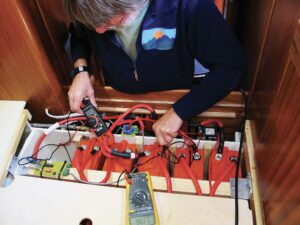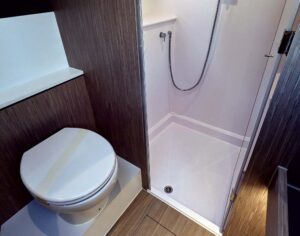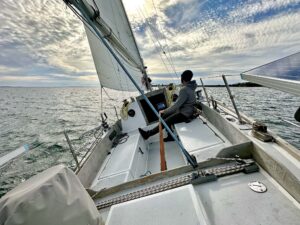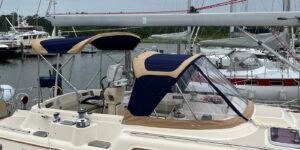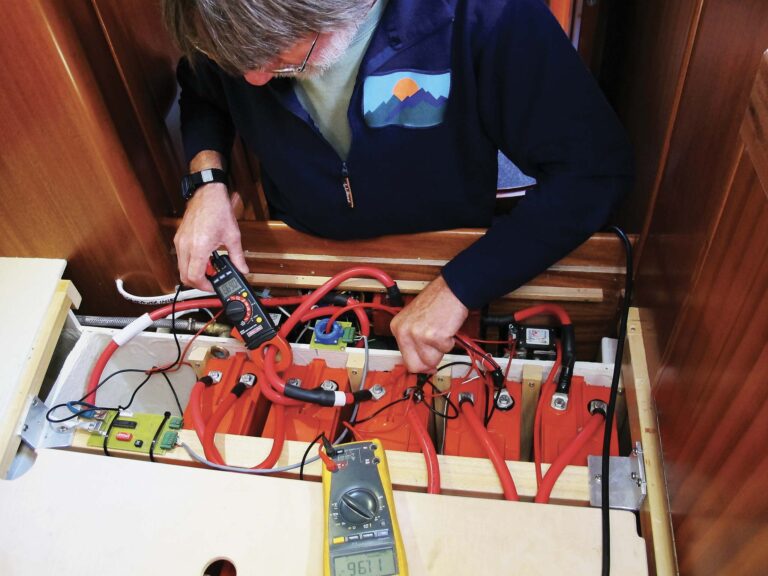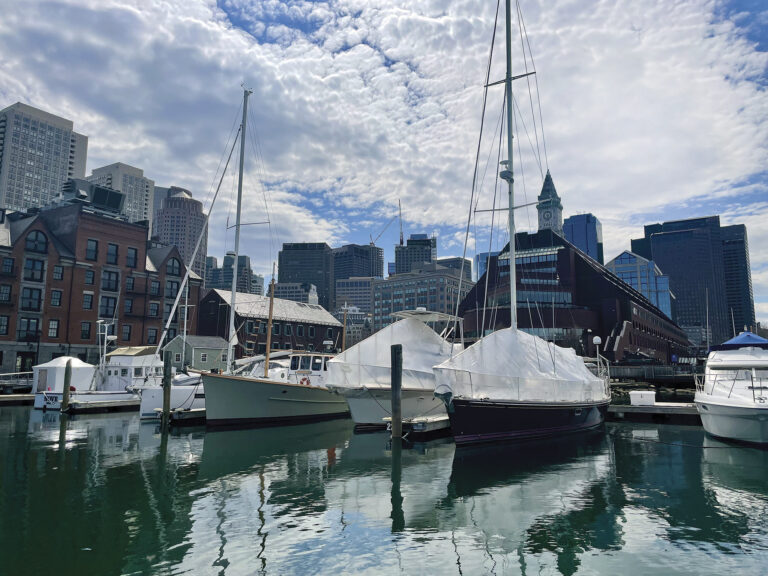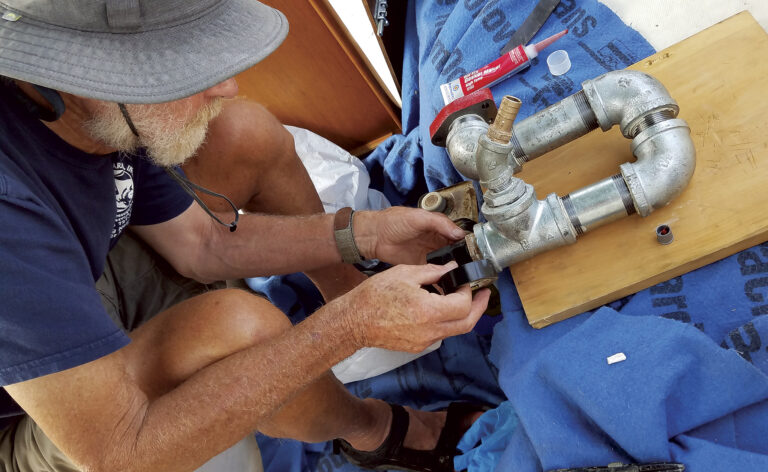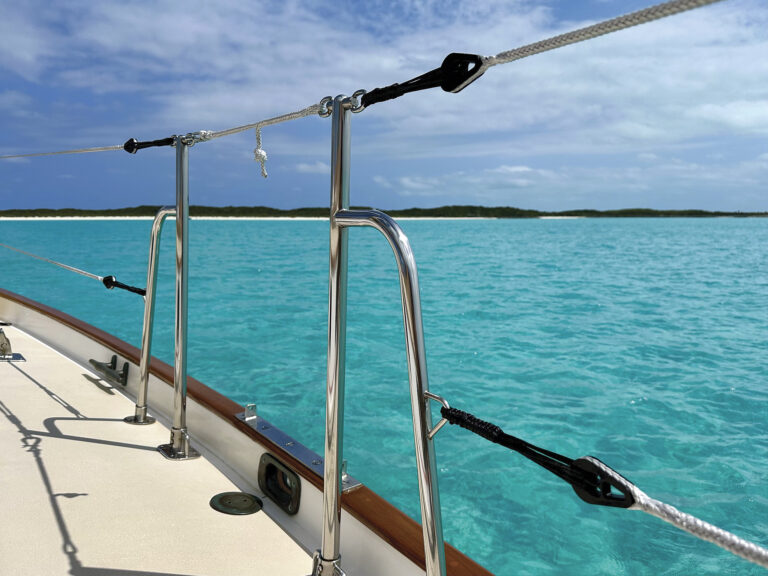PROTECTING THE FIBERS
In order to reduce windage, the parallel-fiber rigging must be compressed to minimize its cross-sectional area, and all fiber rigs must be protected from chafe. PBO and other exotic fibers (unlike carbon and Dynex Dux) also must be protected from environmental conditions. PBO, for example, is damaged by ultraviolet (UV) radiation and moisture intrusion and must be sealed inside a watertight sheathing.
Some PBO manufacturers wrap high-strength “debulking” tape around the fibers to compress them, then wrap heat-shrink tape around this and shrink it down. Others slide a continuous heat-shrink tube over the fibers or extrude a plastic sheath. So long as the heat-shrink or sheath is not damaged, it does a good job of keeping moisture out along the length of the rigging. Waterproofing the cable itself is thus relatively easy. What is not so easy is making the terminals watertight, particularly where the terminal meets the sheath on the rigging itself. Each manufacturer has a somewhat different approach to this.
On fiber rigging, chafe protection may be provided by a braided or extruded sheath. A braided sheath is invariably an exotic Aramid material (e.g., Kevlar or Technora), or high-density polyethylene (e.g., Spectra or Dyneema). When it comes to maintenance, the key requirement is to inspect the rigging for sheathing damage. With PBO, you must be sure the sheath remains UV and moisture resistant.
THE COST OF HIGH TECH
To determine the true cost of fiber rigging we must consider both the upfront cost and the lifetime cost. Kevlar, for example, is about twice the price of rod rigging, PBO is about one and a half times the price of Kevlar (which makes it from two to four times the price of rod), and carbon is more expensive than PBO (at least four times the price of rod). If you start adding titanium end fittings and other exotic touches, costs can go considerably higher. Dynex Dux, in contrast, costs less than rod rigging and is similar to high-quality stainless steel wire (such as Dyform).
But fiber rigging is 70 percent to 80 percent lighter than rod. On a superyacht this saves weight aloft. A refit of a 147-foot? sloop by Future Fibres reduced rig weight from 2,869 lbs to 769 lbs, saving 2,100 lbs. The 170-foot schooner Meteor saved an estimated 3,520 lbs using Composite Rigging’s Element C6 rigging. These savings translate into improved motion and increased stability, better performance to windward, and/or a substantial reduction in the keel weight.
For the same stretch as rod, PBO and carbon standing rigging are about 100 percent stronger. Let’s assume rod rigging with a maximum working load of 40 percent of its ultimate breaking strength. The load on the replacement PBO or carbon rig will be the same, which means a rig with the same stretch will be loaded to 20 percent of its ultimate breaking strength. In theory, there will be reduced fatigue degradation and enhanced life expectancy for the fiber rigs, which has been borne out by laboratory testing.
In practice, no one knows how long these rigs really last. The longest any have been in service is 10 years. As the years go by, manufacturers are becoming increasingly confident about life expectancy.
Over the past decade, fiber rigging has been thoroughly tested on the racecourse, including many of the world’s toughest events such as the Volvo round-the-world race and the Vendee Globe. It has emerged with an enhanced reputation and is increasingly popular, especially on superyachts. New players have introduced lower-cost products (e.g., Powerlite Rigging, Easy Rigging, Colligo Marine and StrongRope). As volume goes up and price comes down, we can expect fiber rigging to increasingly work its way into more price-conscious markets. I would love to test a Dynex Dux rig on my own boat.
Fiber rigs have come of age. Kevlar, PBO, carbon, and Dynex Dux rigs are set to become commonplace…until the next revolutionary fiber supplants them.
RESOURCES
Navtec, www.navtec.com
Future Fibres, www.futurefibres.com
Composite Rigging, www.southernspars.com
Smart Rigging, www.smartrigging.com
Ocean Yacht Systems,
Strong Rope, www.strongrope.com
Easy Rigging, www.easyrigging.com
Colligo Marine, www.colligomarine.com
Powerlite Rigging, www.powerliterigging.com
Hall Spars, www.hallspars.com

